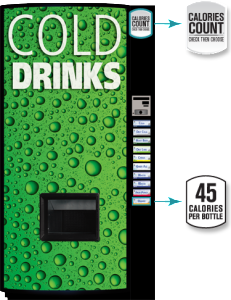NO LAYOUT STYLING YET!
BE CLEAR ON CALORIES
 A uniform calorie label on beverages, consistent in both design and location, makes it easier for consumers to find the beverage option that’s right for them. Florida’s beverage companies are placing easy-to-read calorie labels on the front of every can, bottle and pack we produce.
A uniform calorie label on beverages, consistent in both design and location, makes it easier for consumers to find the beverage option that’s right for them. Florida’s beverage companies are placing easy-to-read calorie labels on the front of every can, bottle and pack we produce.
As part of the Clear on Calories Initiative, launched in 2010 in support of the “Let’s Move” anti-obesity campaign, we added an easy-to-read calorie label to the front of every can, bottle and pack we produce. The labels display the total calories per container on beverages 20 ounces or smaller. For containers larger than 20 ounces, calories are labeled per 12 ounces in most cases. On vending machines, calorie labels are right on the buttons to make it easier to choose the beverage that’s right for you.
Praise for Clear On Calories
“In fact, just today, the nation’s largest beverage companies announced that they’ll be taking steps to provide clearly visible information about calories on the front of their products – as well as on vending machines and soda fountains. This is exactly the kind of vital information parents need to make good choices for their kids.”
– First lady Michelle Obama, as noted in her speech announcing the launch of “Let’s Move!” (Feb. 9, 2010)


BALANCED LIFESTYLES
 Obesity is a serious and complex issue that requires the efforts of individuals, health professionals, businesses and government to solve.
Obesity is a serious and complex issue that requires the efforts of individuals, health professionals, businesses and government to solve.
Our industry understands that obesity is a global concern and we are committed to working alongside business, individuals, academia, government and community organizations to develop workable solutions to the obesity epidemic. While beverages and food play a role in determining good health, so do three main factors: genetics, diet and exercise.
No Silver Bullet in Solving Obesity
There is no silver bullet in solving the obesity issue in the U.S. Weight gain is primarily the result of an imbalance of energy—too many calories consumed versus calories expended. Since people consume many different foods and beverages, no single food or beverage is responsible for people being overweight or obese. But all calories count, whatever food or beverage they come from, including those from our caloric beverages.
Cutting Sugar in the American Diet
Working with the Alliance for a Healthier Generation, we set a bold new goal to reduce beverage calories consumed per person nationally by an additional 20% by 2025. This Balance Calories Initiative is our voluntary, long-term commitment to creating a healthier nation by changing how Americans buy and consume our products.
Part of the Solution
Coca-Cola, Dr Pepper and Pepsi are working together to give families more beverage choices with less sugar. It’s an unprecedented commitment that’s having a positive impact in communities nationwide. The companies are developing new and reformulated beverages and packaging, getting the word out with television ads and in-store displays, working with retailers who know their customers best and partnering with public health advocates and community organizations across the country. Watch the stories behind the largest voluntary effort to fight obesity by any industry at www.BalanceUS.org.

BEVERAGES IN SCHOOLS
School Beverage Guidelines
We have successfully changed the beverage landscape in schools across the country.
 We promised America’s parents that we would change the beverage mix in schools, and our companies – along with their school partners – have delivered dramatic and significant results. With the national School Beverage Guidelines, we removed full-calorie sodas from schools and replaced them with a range of lower-calorie, smaller-portion choices. This has been no easy feat, but it is one we are proud of and we know will have meaningful and lasting results.
We promised America’s parents that we would change the beverage mix in schools, and our companies – along with their school partners – have delivered dramatic and significant results. With the national School Beverage Guidelines, we removed full-calorie sodas from schools and replaced them with a range of lower-calorie, smaller-portion choices. This has been no easy feat, but it is one we are proud of and we know will have meaningful and lasting results.
On Aug. 16, 2012, Dr. Wescott, along with his co-authors, had a peer-reviewed data analysis published in the American Journal of Public Health. The data, which was updated to go through the end of the 2009-2010 school year, shows that industry continues to deliver in schools across America:
- Full-calorie soft drinks have been removed. Shipments of full-calorie soft drinks to schools have declined by 97 percent between 2004, the last comprehensive data available prior to the agreement, and the end of the 2009-2010 school year.
- Calories available from beverages in schools have been cut dramatically. In fact, 90 percent fewer beverage calories were shipped to schools during that time.
- We have successfully changed the beverage landscape in schools across the country. The School Beverage Guidelines provide for a range of lower-calorie, smaller-portion beverage options. As a result, the beverage mix in schools continues to shift to waters, portion-controlled sports drinks, diet drinks and 100 percent juices.
The School Beverage Guidelines are a national standard that is in place and working. We support their adoption as part of the federal regulations for competitive foods in schools.
For complete details on the guidelines visit www.ameribev.org.
